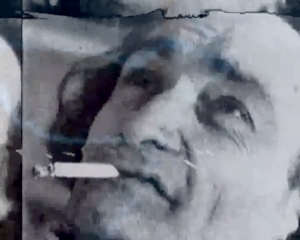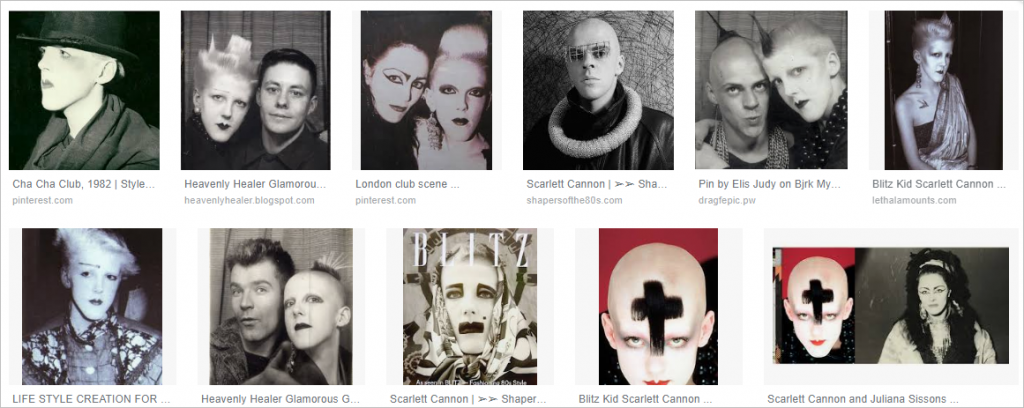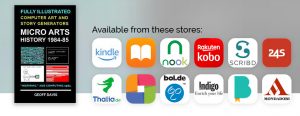Micro Arts was founded by writer/musician and programmer Geoff Davis in 1984. He contacted some friends, otherwise known as ‘an international group of artists and programmers’, who worked on the art programs and provided content for the magazine.
Get the new Micro Arts ebook – universal link
Many artists were involved from the start and all progressed to have interesting careers in the arts and technology.
The original Micro Arts people were:
Geoff Davis (London, Micro Arts was founded in Clapham SW4)
Martin Rootes (Sheffield)
Robin Metcalfe (Sheffield)
Simon Holland (London)
Michèle Gauthier Carr-Brown (France)
William ‘Bill’ Mooney (USA)
Bruno de Florence of NetWork 21 (France, living in London).
Photography by Simon Holland and Michèle Gauthier. With help and support from Akiko Hada, Marie Christine Peyrier, Michele Carter, Cathy Davis, Martin Lacey.
The following biographies are in order of appearance in the project.
Geoff Davis – Summary
Geoff is currently an AI and text researcher at the Creative Computing Institute, University of the Arts London (UAL CCI, Camberwell), and busy with the Micro Arts Group revival. He is producing an ‘Anthology of AI Fiction & Poetry’ with Leopard Print Publishing LPP. Please see geoffdavis.org
After Micro Arts Geoff taught computer graphics at the famous Psalter Lane Art College, Sheffield Hallam University, and the London Institute (now UAL). He completed a Masters in Electronic Arts at Middlesex University (Cat Hill, 2003). The research topic was zoomable user interfaces (ZUIs). A zooming text art piece Calm As A Dead Clam was created in Flash MX. He has since produced several zooming notes and image apps such Story Lite, Story Turbo and the current version:
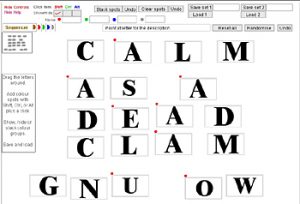
Visit his author site for more about other activities.
Geoff has also had short fiction published (under the name G P Davis) by PEN International (1984), and other books such as Nnn Goes Mobile (1994) in the 1990s. This had a game by Rob Mettler which was on the Arts Council Hub multimedia disk.
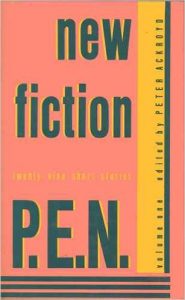
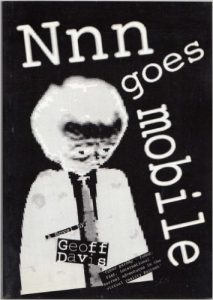
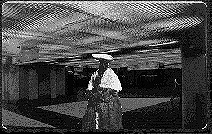
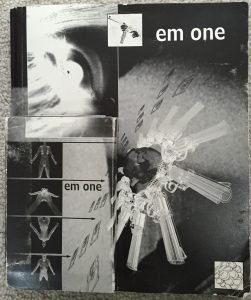
A novella, Death in the Bubble World, was published in the three editions of Em magazine (1997-2000). This had an online animation with music by Paul Greenleaf. The story introduced a fictional electronic currency Easy Money Units, an early electronic currency. This is developed in Geoff’s new novel due 2020.
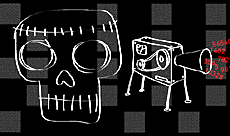
See also Paul Greenleaf’s art website
Music
Geoff is now working with musician and videographer Patryk Jaworski on the synth project Metavista.
Geoff occasionally produces music, from his 1980 Sheffield tape/sound band onwards. Like Martin Rootes (see below) he worked on the ‘Loot’ album, 1990, from Human League member and hit writer Ian Burden. Ian became interested in Geoff’s sample-based songs, one of which used the ‘Loot of the World’ announcement from Kubrik’s Citizen Kane. He has also worked with Nigel Pulsford of Bush, who has a new solo album Losing Track, 2023. In a later change of career, Geoff has also been an eco house developer and manager, and was a founder member of the UK’s Sustainable Development Commission.
For more details see:
Geoff Davis main site for fiction, computer research and music
Martin Rootes
Personal comment
The Micro Arts project coincided with an interesting period in my life. Previously I’d been involved in music with a couple of school friends (including Ian Burden who later joined the Human League). Various events then conspired to kickstart my interest in Computer Graphics. I’d been left £500 in a will, which coincided with the release of the BBC micro and allowed me to purchase BBC Micro. As the sound capabilities were limited I started to investigate what I could do with the graphics. This lead to creating various graphics programs some which ended up on MA3. I also did ‘what’s on next’ videos for both the Hacienda in Manchester and Sheffield’s Leadmill, as well as a for a video of their Plan 9’s song “Red Tin Boxes”.
Eventually I decided that I needed to get a real job and when a computer graphics job in the Medical Illustration Department of Manchester Royal Infirmary came up I decided to go for it.
To impress the interview panel I decided to make a video of various things I’d done but also created an animation of the blood flow through the heart. This did the trick and I was given the job. Unfortunately it didn’t turn out to be the interesting work I’d thought it’d be as the main task was to write a graph drawing program to take hand drawn graphs supplied by the doctors and convert them into nice neat graphs that would photograph well on lithographic film.
When it neared the end of its two and half year contract, I looked for a job back in Sheffield. A job came up at Sheffield City Polytechnic as a Systems Programmer / Analyst. Although it wasn’t a computer graphics job I decided to take it and pursue my other interests in my spare time. Sadly I found that working full time left me with little time to do much, although I still dabbled with music including collaborating with a couple of tracks on Ian Burden’s Loot album and playing with the Wealthy Texans.
After thirty two years working for Sheffield City Polytechnic / Sheffield Hallam University I took early retirement in March 2018. I’ve started getting back into the creative side of computing and have been teaching myself the music programming language Supercollider and I intending looking at using python and Blender to do some more graphics works. One idea is to try and re-create the runner program in 3D using blender.
Martin Rootes , December 2018
Robin Metcalfe
Personal comment
I have just reread the article I wrote for Micro Arts in August 1984. Some things have not changed at all!
I recall Simon “Fiction” [Holland], among other things, introduced me to the Sheffield musician Martyn Ware who was struggling to find a band name. I suggested he look at the works of William Burroughs,but he looked at the back of the soundtrack album of Clockwork Orange. He took on board the sci-fi connection, and chose the name The Human League.
My article [in Micro Arts Magazine – ‘Micro Music’] was fairly accurate in what it suggested would emerge from the jumble of ideas relating to how microprocessors would affect music production. It described as one example of several a purely DSP environment that was not possible then but is common now (and cheap). I doubted at the time that analogue VCO, VCF, ADSR would remain but their raw sound has proven difficult to duplicate.
What has also remained is the way in which a music line composition tends to be of one voicing with adornment. I hoped, and I was not alone, that composition would be more adventurous and that following the ideas of Morton Subotnick (eg ‘Wild Bull’) and Basil Kirchin (e.g.’ Worlds Within Worlds’), music would become more creatively sound dimensional once it was no longer restricted to setting up a voicing that is the same across the keyboard.
When I wrote the article I had just serviced a fully polyphonic Moog which had a complete separate synth board for each note, but the control busses were common to all the modules! Each key produced much the same sound as the next one (except where faulty and out of tune).
As was evidenced at the time by the equipment I made being used by bands (mostly based in Sheffield) the human idea of what is music, is what restricts the output, not the technology.
Micro Arts was a great idea and was nicely open minded – probably too much so. Far more boring and predictable magazines prospered by being pored over by people who wanted to be pop stars not sound artists.
Robin Metcalfe, December 2018
Simon Holland
Brief biography
Simon worked in TV science as an editor for over 30 years. He worked with PBS-NOVA, Discovery Chanel, BBC TV to name a few. After the BBC he set up his own company Reel Editing.
“I made films on lots of interesting subjects. But for every film that makes it onto TV there are hundreds of good ideas that just don’t get made. “
See Simon on YouTube on the ‘Professor Simon’ channel.
‘Professor Simon’ is also on Patreon.
Simon Holland –Prof Simon on YouTube
Student work 1977:
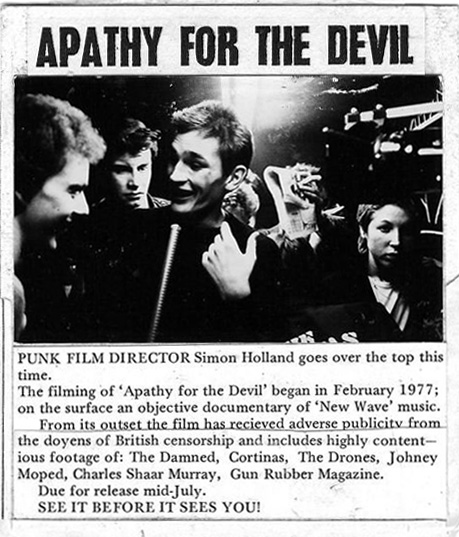
Michèle Gauthier Carr-Brown
Personal comment
Great experience. Micro Arts was set during my studies. For my master courses in Fine Arts, I have worked with Sonia Sheridan and Greg Gundlach, generative systems, Arts and Science. They exhibited their works in the Musée de la Ville de Paris, au Trocadéro, in 1983-84.
In the eighties, when I started advertising work in Paris, computing was not involved, except for the photo-composition of the text. Then, some guy walked into the Agency with a Paint Box, from Quantel.
I was the only one who spoke English and wanted to play with it ! Did I play! long hours until late at night, days after days… I burned my eyes on it… Later came Quark Xpress, for the text, Adobe Illustrator and Photoshop. Brilliant experiences.
The problem has been that often, the computer was in the hands of everyone except artists. I remember some horrible nonsense pictures, where everyone thought they could make a great image….
Today, images are consumed so quickly, the quality does not matter so much, I suppose, for commercial art.
As for me, I am back with my first love, painting oil on canvas.
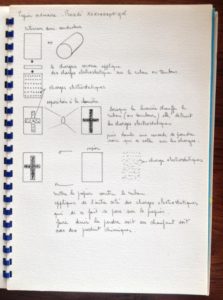
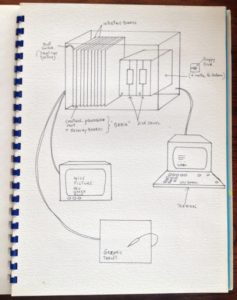
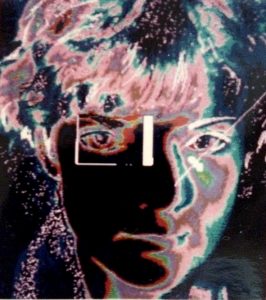
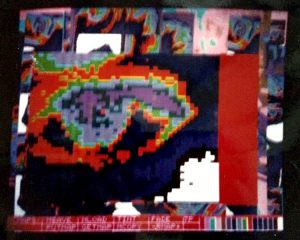
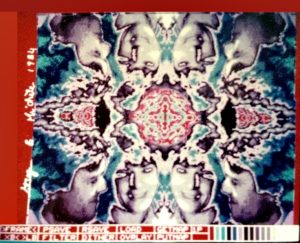
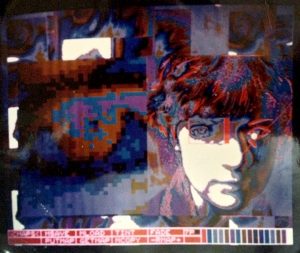
Above:Michèle Gauthier Carr-Brown computer art
Michèle Gauthier Carr-Brown – GAUTH – www.gauth.net
December 2018
Bruno de Florence (NetWork 21)
ONCE UPON A TIME
Different generations do pretty much the same things, which is to exist, but in their own specific ways. So, how did we do things, us visual artists, in the 1980’s?
While the City was gorging itself on drugs, greed & balance sheets, we did not watch TV, not even the nascent Channel 4, went to the Chacha club, attended film shows at the ICA (Institute of Contemporary Arts on The Mall), invented Scratch Video, overdosed on Burroughs’s City of the Red Night, pirated Nam June Paik concept of video installations using malfunctioning old 26” TV sets, organised Super 8 film festival with the Goethe Institute (Alles Macht Der Super 8), perused I-D magazine, and licked Neville Brody’s fonts in The Face magazine. The Internet and mobile phones did not exist, so we didn’t miss them, a typewriter was a luxury item, and a packet of Custard Creams was 13 pence.
Then one day, an inventor from Cambridge dropped a bombshell, a small footprint computer, without a clunky disk drive or screen, which we could connect to an ordinary television set, the Sinclair ZX Spectrum, in glorious 16 colours. We could hack its hardware to get a direct video output, and record it on VHS tape machines, then video- scratch the tape. Its beauty was that we could write and run our own software, as it included a variant of the Basic programming language, whose syntax and vocabulary is close to everyday language. As a result, we could use logic to write warped logic to produce warped graphics, no SDK (Software Developer’s Kit) needed.
We were the Seurat, Matisse & Picasso of the 80’s, all rolled into one, harnessing the movement of electrons inside integrated circuits, instead of being harnessed by them. I think this is how I came to create my Low-Fi aesthetics for my video work. They are all on YouTube. For a taster:
BURROUGHS
http://youtu.be/Z2utpudvV-0
ARTAUD
http://youtu.be/D2jqPRhW4Rk
JAMES JOYCE
http://youtu.be/wcE4cg0B2JA
And please, pretty please, play them ALL at the same time in your browser, in different windows, at full size.
Merci.
Bruno de Florence, Londres, Novembre 2018
NetWork21 TV channel 1980s (Bruno de Florence) – N21 YouTube channel
Bruno de Florence – Bruno channel on YouTube
